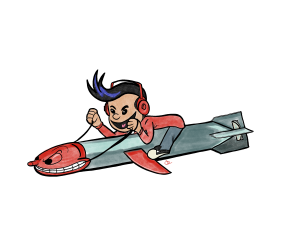What do Tony Robbins, Zig Ziglar, and Brian Tracy have in common? Yes, they're all self help Gurus. Yes, they've helped millions of people realize their dreams. But did you know, all of them based their early work on Maxwell Maltz's 1960's book, Psycho-Cybernetics? In the book, Maltz defines the mind-body connection as the core to achieving your goals.
Most people are so afraid of failure they never attempt to do anything. But, what if there was a way to take your failures and turn them into amazing advantages? In Psycho-Cybernetics, Maltz tells the story of self- guided torpedoes. They set a target, fire the torpedo, and somehow it hits the mark. How do they do it?
guided torpedoes. They set a target, fire the torpedo, and somehow it hits the mark. How do they do it?
They use an internal guidance system. If the torpedo is on target, it does nothing. If the torpedo is off target, it makes a small correction. The torpedo hits its target through a series of mistakes.
Today we'll discuss how anyone can transform awful mistakes into amazing advantages using The Course Corrector Tool.
The Self Guided Torpedo
In 1866, British engineer, Robert Whitehead developed the self guided torpedo. Back then they didn't have G.P.S., computers, or satellites. The systems that guided the torpedo were extremely simple. With that in mind, we've kept the Course Corrector Tool quite simple.
To get started you'll need a quiet place to think. A pen and paper to write on. And a target you want to hit. Now, let's take a look at how to use this powerful tool.
How to use The Course Corrector Tool
Start by identifying the target you want to hit. This could be a personal or business goal. Maybe it's shedding a few extra pounds or landing that next big client. Write that goal at the top of the page. Underneath you'll write these three questions:
- What worked? It's important to ask ourselves this question first. Why? Because we want to keep doing what's working when we're in pursuit of our goals. This is a form of positive reinforcement.
- What didn't work? This is the most important question, yet most people avoid it. Like the torpedo, we need to know when we're off track so we can make an adjustment. Most people are afraid of making mistakes and this keeps them stuck exactly where they are. To grow, we must look at failure as feedback. Nothing more, nothing less.
- What could I do differently? This is where the magic happens. Once we've identified what didn't work, we can make the correction to get us back on course.
Before moving on, a quick story on corrections. Do you remember when you were first learning to drive? How fun and exciting it was. You were finally in control and you felt free. But steering a car was new to you. If you got too far to the left or the right, you jerked the steering wheel in the other direction. Before you knew it you were too far the other way and jerking the steering wheel again. For a second, it felt like you were on some crazy carnival ride. You overcorrected.
Overcorrecting is common. In the next section we'll explore why small, incremental changes are best when using the Course Corrector tool.
When to use The Course Corrector Tool
If we asked our doctor when we should eat right and exercise, what would he say? Everyday. And so it is with the Course Corrector tool. The more we use it the better our results. At minimum it can be used once per week to make sure we're on course to hit our goals. Personally, I use it daily to ensure I'm learning from my mistakes and powering forward towards my goals.
The entire process takes less than five minutes and gives you confidence that you're on the right path. Use it often and turn your awful mistakes into amazing advantages.
Are you on course?
Hitting your goals is the destination. To get there, we must be certain we’re on the right track. Using the Course Corrector Tool we’ll know what works – so we can keep doing it. When we’re off course, we’ll know it quickly and we’ll be able to make a course correction to get back on track.
Zeroing in on your goals
Today we talked about using The Course Corrector tool to stay on track towards your goals. I recommended using the tool daily. This kind of dedication takes a lot of self discipline. If you want to get better at self discipline, listen to this training https://thepodcastfactory.com/dwp011/ to help you zero in on your goals.
What else do Tony Robbins, Zig Ziglar, and Brian Tracy have in common? They built massive platforms to reach more people they can help. Today, you can build your own platform to reach massive amounts of people through podcasting.
My team has helped 50 esports just like you reach more people, turn them into raving fans, and amazing clients – through podcasting. I can show you how it works in a quick 30 minute call. Book a time to talk at https://thepodcastfactory.com/start/



